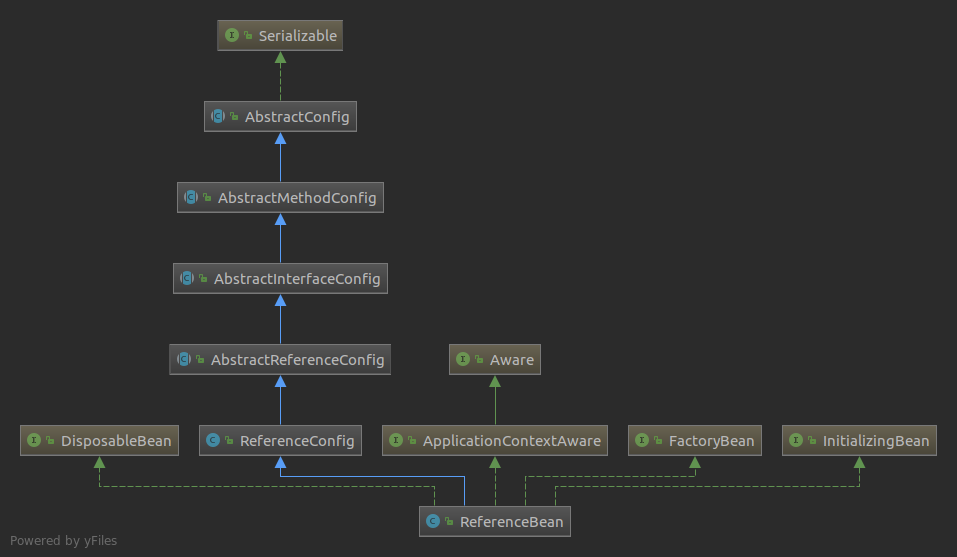1
2
3
4
5
6
7
8
9
10
11
12
13
14
15
16
17
18
19
20
21
22
23
24
25
26
27
28
29
30
31
32
33
34
35
36
37
38
39
40
41
42
43
44
45
46
47
48
49
50
51
52
53
54
55
56
57
58
59
60
61
62
63
64
65
66
67
68
69
70
71
72
73
74
75
76
77
78
79
80
81
82
83
84
85
86
87
88
89
90
91
92
93
94
95
96
97
98
99
100
101
102
103
104
105
106
107
108
109
110
111
112
113
114
115
116
117
118
119
120
121
122
123
124
125
126
127
128
129
130
131
132
133
134
135
136
137
138
139
140
141
142
143
144
145
146
147
148
149
150
151
152
153
154
155
156
157
158
159
160
161
162
163
164
165
166
167
168
169
170
171
172
173
174
175
176
177
| @SuppressWarnings("unchecked")
private static BeanDefinition parse(Element element, ParserContext parserContext, Class<?> beanClass, boolean required) {
RootBeanDefinition beanDefinition = new RootBeanDefinition();
beanDefinition.setBeanClass(beanClass);
beanDefinition.setLazyInit(false);
String id = element.getAttribute("id");
if ((id == null || id.length() == 0) && required) {
String generatedBeanName = element.getAttribute("name");
if (generatedBeanName == null || generatedBeanName.length() == 0) {
if (ProtocolConfig.class.equals(beanClass)) {
generatedBeanName = "dubbo";
} else {
generatedBeanName = element.getAttribute("interface");
}
}
if (generatedBeanName == null || generatedBeanName.length() == 0) {
generatedBeanName = beanClass.getName();
}
id = generatedBeanName;
int counter = 2;
while (parserContext.getRegistry().containsBeanDefinition(id)) {
id = generatedBeanName + (counter++);
}
}
if (id != null && id.length() > 0) {
if (parserContext.getRegistry().containsBeanDefinition(id)) {
throw new IllegalStateException("Duplicate spring bean id " + id);
}
parserContext.getRegistry().registerBeanDefinition(id, beanDefinition);
beanDefinition.getPropertyValues().addPropertyValue("id", id);
}
if (ProtocolConfig.class.equals(beanClass)) {
for (String name : parserContext.getRegistry().getBeanDefinitionNames()) {
BeanDefinition definition = parserContext.getRegistry().getBeanDefinition(name);
PropertyValue property = definition.getPropertyValues().getPropertyValue("protocol");
if (property != null) {
Object value = property.getValue();
if (value instanceof ProtocolConfig && id.equals(((ProtocolConfig) value).getName())) {
definition.getPropertyValues().addPropertyValue("protocol", new RuntimeBeanReference(id));
}
}
}
} else if (ServiceBean.class.equals(beanClass)) {
String className = element.getAttribute("class");
if (className != null && className.length() > 0) {
RootBeanDefinition classDefinition = new RootBeanDefinition();
classDefinition.setBeanClass(ReflectUtils.forName(className));
classDefinition.setLazyInit(false);
parseProperties(element.getChildNodes(), classDefinition);
beanDefinition.getPropertyValues().addPropertyValue("ref", new BeanDefinitionHolder(classDefinition, id + "Impl"));
}
} else if (ProviderConfig.class.equals(beanClass)) {
parseNested(element, parserContext, ServiceBean.class, true, "service", "provider", id, beanDefinition);
} else if (ConsumerConfig.class.equals(beanClass)) {
parseNested(element, parserContext, ReferenceBean.class, false, "reference", "consumer", id, beanDefinition);
}
Set<String> props = new HashSet<String>();
ManagedMap parameters = null;
for (Method setter : beanClass.getMethods()) {
String name = setter.getName();
if (name.length() > 3 && name.startsWith("set")
&& Modifier.isPublic(setter.getModifiers())
&& setter.getParameterTypes().length == 1) {
Class<?> type = setter.getParameterTypes()[0];
String property = StringUtils.camelToSplitName(name.substring(3, 4).toLowerCase() + name.substring(4), "-");
props.add(property);
Method getter = null;
try {
getter = beanClass.getMethod("get" + name.substring(3), new Class<?>[0]);
} catch (NoSuchMethodException e) {
try {
getter = beanClass.getMethod("is" + name.substring(3), new Class<?>[0]);
} catch (NoSuchMethodException e2) {
}
}
if (getter == null
|| !Modifier.isPublic(getter.getModifiers())
|| !type.equals(getter.getReturnType())) {
continue;
}
if ("parameters".equals(property)) {
parameters = parseParameters(element.getChildNodes(), beanDefinition);
} else if ("methods".equals(property)) {
parseMethods(id, element.getChildNodes(), beanDefinition, parserContext);
} else if ("arguments".equals(property)) {
parseArguments(id, element.getChildNodes(), beanDefinition, parserContext);
} else {
String value = element.getAttribute(property);
if (value != null) {
value = value.trim();
if (value.length() > 0) {
if ("registry".equals(property) && RegistryConfig.NO_AVAILABLE.equalsIgnoreCase(value)) {
RegistryConfig registryConfig = new RegistryConfig();
registryConfig.setAddress(RegistryConfig.NO_AVAILABLE);
beanDefinition.getPropertyValues().addPropertyValue(property, registryConfig);
} else if ("registry".equals(property) && value.indexOf(',') != -1) {
parseMultiRef("registries", value, beanDefinition, parserContext);
} else if ("provider".equals(property) && value.indexOf(',') != -1) {
parseMultiRef("providers", value, beanDefinition, parserContext);
} else if ("protocol".equals(property) && value.indexOf(',') != -1) {
parseMultiRef("protocols", value, beanDefinition, parserContext);
} else {
Object reference;
if (isPrimitive(type)) {
if ("async".equals(property) && "false".equals(value)
|| "timeout".equals(property) && "0".equals(value)
|| "delay".equals(property) && "0".equals(value)
|| "version".equals(property) && "0.0.0".equals(value)
|| "stat".equals(property) && "-1".equals(value)
|| "reliable".equals(property) && "false".equals(value)) {
value = null;
}
reference = value;
} else if ("protocol".equals(property)
&& ExtensionLoader.getExtensionLoader(Protocol.class).hasExtension(value)
&& (!parserContext.getRegistry().containsBeanDefinition(value)
|| !ProtocolConfig.class.getName().equals(parserContext.getRegistry().getBeanDefinition(value).getBeanClassName()))) {
if ("dubbo:provider".equals(element.getTagName())) {
logger.warn("Recommended replace <dubbo:provider protocol=\"" + value + "\" ... /> to <dubbo:protocol name=\"" + value + "\" ... />");
}
ProtocolConfig protocol = new ProtocolConfig();
protocol.setName(value);
reference = protocol;
} else if ("onreturn".equals(property)) {
int index = value.lastIndexOf(".");
String returnRef = value.substring(0, index);
String returnMethod = value.substring(index + 1);
reference = new RuntimeBeanReference(returnRef);
beanDefinition.getPropertyValues().addPropertyValue("onreturnMethod", returnMethod);
} else if ("onthrow".equals(property)) {
int index = value.lastIndexOf(".");
String throwRef = value.substring(0, index);
String throwMethod = value.substring(index + 1);
reference = new RuntimeBeanReference(throwRef);
beanDefinition.getPropertyValues().addPropertyValue("onthrowMethod", throwMethod);
} else if ("oninvoke".equals(property)) {
int index = value.lastIndexOf(".");
String invokeRef = value.substring(0, index);
String invokeRefMethod = value.substring(index + 1);
reference = new RuntimeBeanReference(invokeRef);
beanDefinition.getPropertyValues().addPropertyValue("oninvokeMethod", invokeRefMethod);
} else {
if ("ref".equals(property) && parserContext.getRegistry().containsBeanDefinition(value)) {
BeanDefinition refBean = parserContext.getRegistry().getBeanDefinition(value);
if (!refBean.isSingleton()) {
throw new IllegalStateException("The exported service ref " + value + " must be singleton! Please set the " + value + " bean scope to singleton, eg: <bean id=\"" + value + "\" scope=\"singleton\" ...>");
}
}
reference = new RuntimeBeanReference(value);
}
beanDefinition.getPropertyValues().addPropertyValue(property, reference);
}
}
}
}
}
}
NamedNodeMap attributes = element.getAttributes();
int len = attributes.getLength();
for (int i = 0; i < len; i++) {
Node node = attributes.item(i);
String name = node.getLocalName();
if (!props.contains(name)) {
if (parameters == null) {
parameters = new ManagedMap();
}
String value = node.getNodeValue();
parameters.put(name, new TypedStringValue(value, String.class));
}
}
if (parameters != null) {
beanDefinition.getPropertyValues().addPropertyValue("parameters", parameters);
}
return beanDefinition;
}
|



